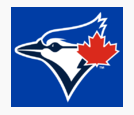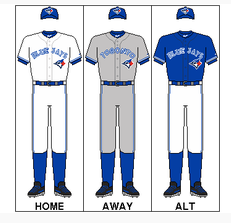
| Toronto Blue Jays | |||||
| 2013 Toronto Blue Jays season | |||||
| Established | 1977 | ||||
|
|||||
| Major league affiliations | |||||
|
American League (1977–present) East Division (1977–present) |
|||||
| Current uniform | |||||
|
|||||
| Retired numbers | 12 · 42 | ||||
| Colors | |||||
|
Royal blue, navy blue, white, red |
|||||
| Name | |||||
| Toronto Blue Jays (1977–present) | |||||
| Other nicknames | |||||
| The Jays | |||||
| Ballpark | |||||
|
Rogers Centre (1989–present) a.k.a. SkyDome (1989–2005) Exhibition Stadium (1977–1989) |
|||||
| Major league titles | |||||
| World Series titles (2) | 1993 · 1992 | ||||
| AL Pennants (2) | 1993 · 1992 | ||||
| East Division titles (5) | 1993 · 1992 ·1991 · 1989 · 1985 | ||||
| Wild card berths (0) | |||||
| Front office | |||||
| Owner(s) | Rogers Communications | ||||
| Manager | John Gibbons | ||||
| General Manager | Alex Anthopoulos | ||||
| President of Baseball Operations | Paul Beeston | ||||
The Toronto Blue Jays are a professional baseball team located in Toronto, Ontario, Canada. The Blue Jays are a member of the Eastern Division of Major League Baseball (MLB)'s American League (AL).
The "Blue Jays" name originates from the bird of the same name, and the fact that blue is the traditional colour of Toronto's other professional sports teams, the Maple Leafs (ice hockey) and the Argonauts (football). Nicknamed "the Jays", the team's official colours are royal blue, navy blue, white, and red.[1] An expansion franchise, the club was founded in Toronto in 1977, initially owned by the Labatt Brewing Company. Originally based at Exhibition Stadium, the team began playing its home games at the SkyDome, upon completion of its construction in 1989. Since 2000, the Blue Jays have been owned by Rogers Communications, and in 2004, the SkyDome was purchased by that company, which renamed the venue to Rogers Centre. They are the second MLB team to be based outside the United States, and currently the only team outside the U.S. after fellow Canadian franchise, the Montreal Expos, relocated to Washington, D.C. after the 2004 season (becoming the Washington Nationals).
In the late 1970s and early 1980s, the Blue Jays went through struggles typical of an expansion team, frequently finishing in last place in their division. In 1983, the team had its first winning season, and two years later, they became division champions. From 1985–1993, the Blue Jays were an AL East powerhouse, winning five division championships in nine seasons, including three consecutive from 1991–93. During their run of three straight division championships, the team also became back-to-back World Series champions from 1992–93, led by a core group ofaward-winning All-Star players, including Hall of Famer Roberto Alomar, Joe Carter, John Olerud, and Devon White. They became the first (and to date, only) team outside the U.S. to appear in and win a World Series, and the fastest AL expansion team to do so, winning in their 16th year. Since 1993, the Blue Jays have not made the playoffs, though they have remained competitive in their division.
The Blue Jays are one of three MLB teams under corporate ownership, with the other two being the Seattle Mariners (Nintendo of America) and the Atlanta Braves (Liberty Media).
History
Main article: History of the Toronto Blue Jays
1977–1994: The Pat Gillick era
1977–1981
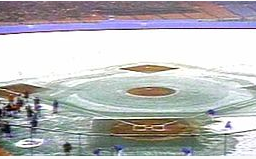
April 7, 1977. A snow-covered field prior to the first Blue Jays game at Exhibition Stadium.
The Blue Jays played their first game on April 7, 1977, against the Chicago White Sox, before a home crowd of 44,649. The game is now perhaps best remembered for the minor snowstorm which began just before the game started. Toronto won the snowy affair 9–5, led by Doug Ault's two home runs. That win would be one of only 54 of the 1977 season, as the Blue Jays finished in last place in the AL East, with a record of 54–107. After the season, assistant general manager Pat Gillick succeeded Peter Bavasi as general manager of the team, a position he would hold until 1994.[2]
In 1978, the team improved their record by five games, but remained last, with a record of 59–102. In 1979, after a 53–109 last place finish, shortstop Alfredo Griffin was named American League co-Rookie of the Year. In addition, the Blue Jays' first mascot, BJ Birdy, made its debut in 1979.
In 1980, Bobby Mattick became manager, succeeding Roy Hartsfield, the Blue Jays' original manager. In Mattick's first season as manager, although they remained at the bottom, Toronto almost reached the 70-win mark, finishing with a record of 67–95, a 14-win improvement on 1979. Jim Clancy led with 13 wins and John Mayberry became the first Jay to hit 30 home runs in a season.
In the strike-divided season of 1981, the Blue Jays finished in last place in the AL East in both halves of the season. They were a dismal 16–42 in the first half, but improved dramatically, finishing the 48-game second half at 21–27, for a combined record of 37–69.
1982–84
Under new manager Bobby Cox, Toronto's first solid season came in 1982 as they finished 78–84. Their pitching staff was led by starters Dave Stieb, Jim Clancy and Luis Leal, and the outfield featured a young Lloyd Moseby and Jesse Barfield. 1982 was also the Blue Jays' first season outside the bottom, as they finished sixth in the East out of seven teams.
In 1983, the Blue Jays compiled their first winning record, 89–73, finishing in fourth place, nine games behind the eventual World Series champions, the Baltimore Orioles. First baseman Willie Upshaw became the first Blue Jay to have at least 100 RBIs in a season.
The Blue Jays' progress continued in 1984, finishing with the same 89–73 record, but this time in a distant second place behind another World Series champion, the Detroit Tigers. After 1984, Alfredo Griffin went to the Oakland Athletics, thus giving a permanent spot to young Dominican shortstop Tony Fernández, who would become a fan favorite for many years.
1985: The first AL East title
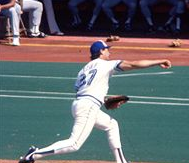
Dave Stieb has the second highest number of wins among pitchers in the 1980s.
Main article: 1985 Toronto Blue Jays season
In 1985, Toronto won their first championship of any sort: the first of their five American League East division titles. The Blue Jays featured strong pitching and a balanced offense. Tony Fernández excelled in his first full season, and veteran pitcher Doyle Alexander led the team with 17 wins, including a division-clinching complete game win. Their mid-season call up of relief pitcher Tom Henke also proved to be important. They finished 99–62 (the franchise record for most wins), two games in front of the New York Yankees. The Blue Jays faced the Kansas City Royals in the American League Championship Series(ALCS), and took a three games to one lead (known as the "Drive of '85").[3] However, Kansas City won three consecutive games to win the series 4–3, on the way to their first, and only, World Serieschampionship.
After the playoffs, AL Manager of the Year, Bobby Cox, suddenly left the Blue Jays to become general manager of the Atlanta Braves, the team he previously managed.
1986–88
With Jimy Williams now the skipper, the Blue Jays could not duplicate their success in 1986, sliding to a fourth-place tie at 86–76. Jesse Barfield and George Bell led the way with 40 and 31 home runs, respectively, while Jim Clancy, Mark Eichhorn, and Jimmy Key tied for the team wins lead with 14 each.
In 1987, the Blue Jays lost a thrilling division race to the Detroit Tigers by two games, after being swept on the last weekend of the season by the Tigers. The Blue Jays finished with a 96–66 record, second best in the major leagues, but to no avail. However, George Bell (.308 AVG, 47 HR, 134 RBI) was named the AL's Most Valuable Player (MVP), the only Blue Jay to be named so.
In 1988, however, Toronto could not duplicate the successes of the previous season. They tied the Milwaukee Brewers for third in the division at 87–75, only two games behind the division champion Boston Red Sox. Still, the season had numerous highlights. First baseman Fred McGriff hit 34 home runs, and Dave Stieb had back-to-back starts in which he lost a no-hitter with two out and two strikes in the ninth inning.
1989–1991: Cito Gaston takes charge, two more AL East titles
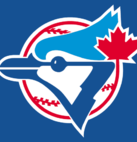
The Toronto Blue Jays cap logo (1977–1996)
In 1989, the Blue Jays' new retractable roofed home, SkyDome, opened in mid-season. It also marked the beginning of an extremely successful five-year period for the team. In May, management fired manager Jimy Williams and replaced him with Cito Gaston, the team's hitting instructor. The club had a dismal 12–24 record at the time of the firing, but went 77–49 under Gaston to win the AL East title by two games, with an 89–73 record. On May 28, George Bell's walk-off home run, off of Chicago White Sox closer Bobby Thigpen, marked the end of the Exhibition Stadium era. The first game at the new stadium took place on June 5 against the Milwaukee Brewers; the Jays lost 5–3. In the 1989 ALCS, Rickey Henderson led the World Series champion Oakland Athletics to a 4–1 series win.
In 1990, the Blue Jays again had a strong season, but finished in second place, two games behind the Boston Red Sox. Dave Stieb pitched his only no-hitter, beating the Cleveland Indians 3–0 in front of a less than capacity crowd at Cleveland Municipal Stadium. As of 2012, it remains the only no-hitter ever pitched by a Blue Jay. During the offseason, the Blue Jays made one of the two biggest trades in franchise history, sending All-Star shortstop Tony Fernández and first baseman Fred McGriff to the San Diego Padres in exchange for outfielder Joe Carter and second baseman Roberto Alomar. The Jays also obtained center fielder Devon White from the California Angels. These deals, particularly the trade with San Diego, were instrumental in the team's future success.
Carter, Alomar and White would prove to be extremely effective additions, as the Blue Jays again won the division in 1991, as Carter drove in Alomar for the division-winning run. Once again, however, they fell short in the postseason, losing to the Minnesota Twins, who were on the way to their second World Series victory in five seasons, in the ALCS. In 1991, the Blue Jays became the first Major League club ever to draw over four million fans in one season.
• Team record 1989: 89 wins–73 losses, W%- 0.549
• Team record 1990: 86 wins–76 losses, W%- 0.531, 2 games behind division leader
• Team record 1991: 91 wins–71 losses, W%- 0.562
1992–93: World Series champions
1992: Canada's first World Series title
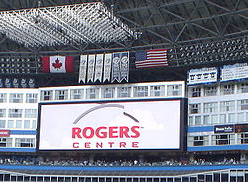
Eight Blue Jays banners (previously six, as shown) hang above the Rogers Centre videoboard. The four white banners mark the Blue Jays' 1985, 1989, and 1991 division championships, as well as Toronto's hosting of the 1991 All-Star Game. The two blue banners are for the 1992 and 1993 World Series teams. (Two other banners, in light blue, exist to represent the team's two American League championships, but do not hang.)
Main article: 1992 Toronto Blue Jays season
After the 1991 season had ended, the Blue Jays acquired pitcher Jack Morris, who had led the Minnesota Twins to victory in the World Series by pitching a 10-inning complete game shutout in Game 7 and had been named the World Series MVP. To add veteran leadership to their explosive offense, Toronto signed Dave Winfield to be the team's designated hitter.
The 1992 regular season went well, as the Jays clinched their second straight AL East crown with a final record of 96–66, four games ahead of the Milwaukee Brewers. They also went the entire season without being swept in any series. The Blue Jays met the Oakland Athletics (who had the same record as the Jays and led the division by six games over the defending champion Twins) in the ALCS, winning four games to two. The pivotal game of the series was Game 4, considered by many to be one of the most important games in Blue Jays history: the Blue Jays rallied back from a 6–1 deficit after seven innings, capped off by Roberto Alomar's huge game-tying two-run homer off A's closer Dennis Eckersley in the top of the ninth. This paved the way for a 7–6 victory in 11 innings, a 3-games-to-1 lead in the series and an eventual 4–2 ALCS series win.
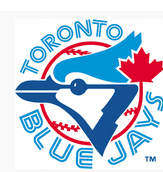
The original Toronto Blue Jays logo (1977–1996)
The Blue Jays then faced the Atlanta Braves in the World Series. The Braves returned after being beaten by the Twins the previous year. The pivotal game in this series turned out to be Game 2, in which reserve player Ed Sprague hit a 9th-inning two-run home run off Braves closer Jeff Reardon to give the Blue Jays a 5–4 lead, which would hold up. After winning Game 3 thanks to Candy Maldonado's ninth inning RBI hit and Game 4 due to Jimmy Key's superb 7⅓ inning pitching effort in which he retired 15 straight batters (five innings), the Jays could not win the Series on home turf as the Braves struck back with a 7–2 win in Game 5. Game 6 in Atlanta, with the Blue Jays leading 3 games to 2, was a very close game. Toronto was one strike away from winning in the bottom of the 9th inning, 2–1,[4] but Otis Nixon singled in the tying run off the Blue Jays' closerTom Henke. It was the first run the Toronto bullpen had given up in the series. The game was decided in the 11th inning, when Dave Winfield doubled down the left-field line, driving in two runs. The Braves would again come within one run in the bottom of the 11th, but Jays reliever Mike Timlin fielded Otis Nixon's bunt, throwing to Joe Carter at first base for the final out. The Blue Jays became the first team based outside of the United States to win the World Series. Pat Borders, the Jays' catcher, was the unlikely player who was named MVP after hitting .450 with one home run in the World Series. Oddly, Morris was acquired in large part for his reputation as a clutch postseason pitcher, but he went 0–3 in the playoffs. Morris, however, pitched well in the regular season, becoming the Blue Jays' first 20-game winner, with a record of 21–6 and an ERA of 4.04.
• Team record 1992: 96 wins–66 losses, W%- 0.593
1993: Back-to-back champs
Main article: 1993 Toronto Blue Jays season
After the 1992 season, the Blue Jays let World Series hero Dave Winfield and longtime closer Tom Henke go but signed two key free agents: designated hitter Paul Molitor from the Milwaukee Brewers and perennial playoff success Dave Stewartfrom the Oakland Athletics.
In 1993, the Blue Jays had seven All-Stars: outfielders Devon White and Joe Carter, infielders John Olerud and Roberto Alomar, designated hitter Molitor, plus starting pitcher Pat Hentgen, and closer Duane Ward. In August, the Jays acquired former nemesis Rickey Henderson from the Athletics. The Blue Jays cruised to a 95–67 record, one less win than 1992 and seven games ahead of the New York Yankees, winning their third straight division title. The Jays beat theChicago White Sox four games to two in the ALCS, and then the Philadelphia Phillies, four games to two, for their second straight World Series victory. The World Series featured several exciting games, including Game 4, played under a slight rain, in which the Blue Jays came back from a 14–9 deficit to win 15–14 and take a 3 games to 1 lead in the series. It remains the highest scoring game in World Series history. Game 6 in Toronto saw the Blue Jays lead 5–1, but give up 5 runs in the 7th inning to trail 6–5. In the bottom of the 9th inning, Joe Carter hit a one-out, three-run walk-off home run to clinch the series off of Phillies closer Mitch Williams. Only the second World Series–winning walk-off home run in the history of Major League Baseball (following Bill Mazeroski's in Game 7 in 1960), Carter's hit differed from the first in that Toronto, while not facing elimination, was trailing in the bottom of the 9th. The home run is also memorable for late Blue Jays broadcaster Tom Cheek's call:
A swing, and a belt! Left field! Way back! Blue Jays win it! The Blue Jays are World Series champions as Joe Carter hits a three-run home run in the ninth inning and the Blue Jays have repeated as World Series champions! Touch 'em all, Joe, you'll never hit a bigger home run in your life!
– Tom Cheek, late Blue Jays radio play-by-play announcer
In the regular season, three Blue Jays—John Olerud, Paul Molitor and Roberto Alomar—finished 1–2–3 for the AL batting crown, led by Olerud's franchise record .363 average. It was the first time in 100 years that the top three hitters in the league were from the same team.[2][5]
• Team record 1993: 95 wins–67 losses, W%- 0.586



